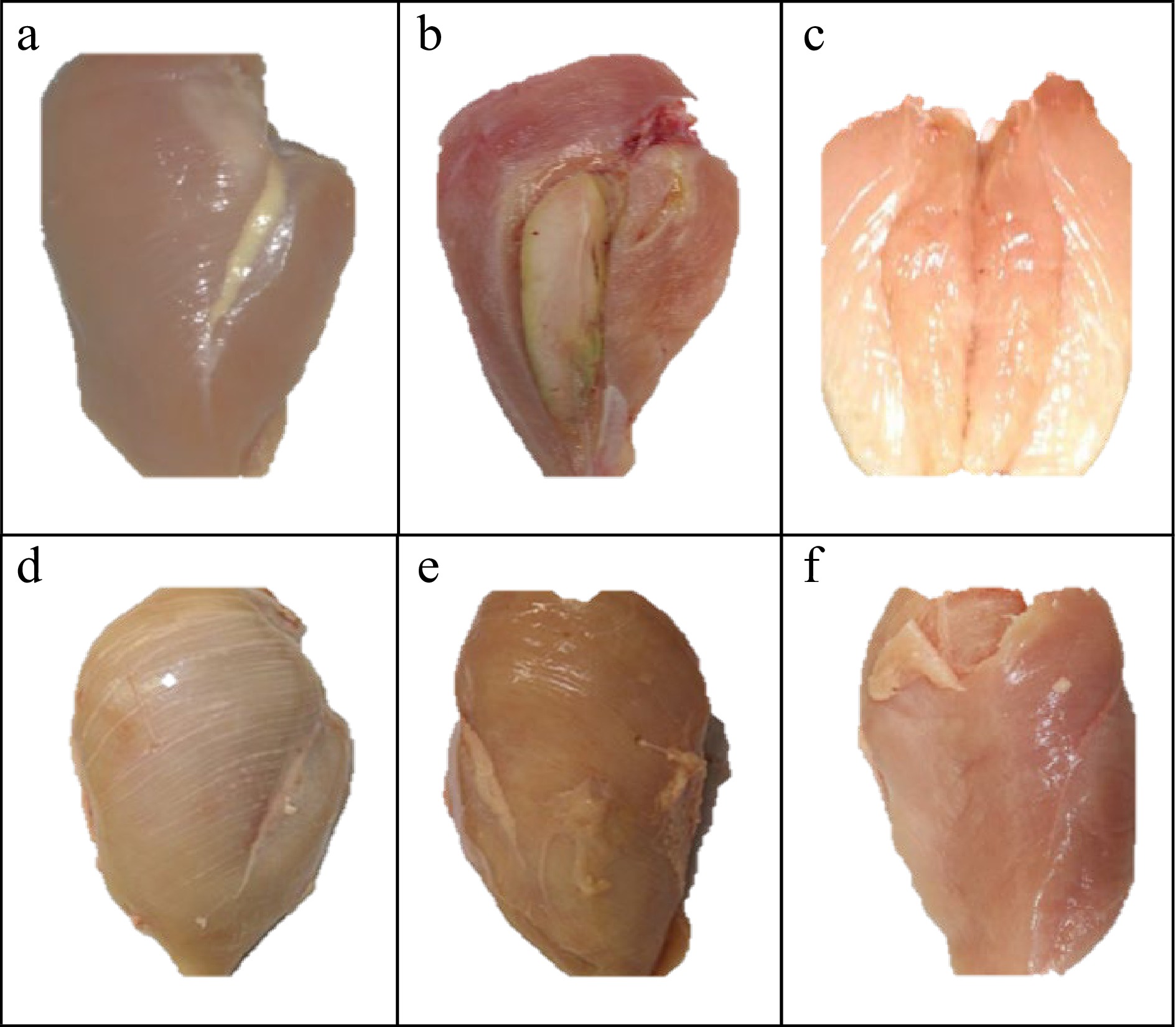-

Figure 1.
Normal and different abnormal types of broiler breast meat. (a) Normal meat, (b) deep pectoral muscle, (c) PSE-like meat, (d) white-striping, (e) wooden breast, (f) spaghetti meat.
-

Figure 2.
Formation mechanisms of abnormal meat.
-
Item Appearance Quality characteristics Meat gel quality Reference DPM (deep pectoral muscle) The muscles color turns green Z-line disintegration; actin filaments decomposition; nuclear and organelle destruction Not investigated Lilburn et al. (2019);
Barbut et al. (2019)PSE (pale, soft and exudative) -like broiler meat Pale, soft and exudative Proteins solubility declines; myosin thermal stability and pH decline Gel structure and WHC (Water holding capacity) of salt soluble protein decreased Grashorn (2010);
Chen et al. (2018);
Dong et al. (2020)WB (wooden breast) Texture hardness, the caudal area has a ridge protrusion Protein content and water holding capacity (WHC) declines; hardness, pH, water content and crude fat content increased Gel microstructure loose; have a higher α-helix content, lower β-sheet and β-turn content
Same as WBBaldi et al. (2019);
Soglia et al. (2020);
Liu et al. (2011)WS (white-striping) White fat deposits Same as WB Same as WB Kuttappan et al. (2016) SM (spaghetti meat) Impaired muscular integrity, connective tissue sparse Muscle pH, WHC, and protein solubility declined; emulsion stability impaired Not investigated Baldi et al. (2017);
Tasoniero et al. (2020)Table 1.
Impacts of broiler muscle myopathies/abnormalities on organoleptic and functional properties of muscles and proteins.
-
Item Detection and grading Comment References PSE-like broiler meat pH and L* values Destructive, time-consuming and unsuitable Li et al. (2014);
Bowker et al. (2014)Dielectric spectra in radiofrequency and microwave ranges Depending on the level of protein degradation to grade meat Victoria et al. (2018) PCA with Vis/NIR Classification of intact broiler breast fillets into different quality grades Yang et al. (2018) Hyperspectral imaging (HSI) A rapid and impactive method to predict quality
traits and grades of broiler meatYang et al. (2020) WS/WB Artificial ratings (Finger pressing) Poor stability, low repeatability and non-uniform evaluation system Cai et al. (2018) Frequency-radiometric spectrometry (FRS) Detection and grading of WS Traffano-Schiffo et al. (2017) Near-infrared spectroscopy (NIS) Rapid online detection and grading of the WB Wold et al. (2017) Computer vision system (CVS) Based on vision system for WB classification Geronimo et al. (2019) Bioelectrical impedance analysis (BIA) Based on outer, inner, and tail areas for WB classification Morey et al. (2020) Near infrared with linear discriminant analysis method Portable and nondestructive de Carvalho et al.
(2020)Time-domain nuclear magnetic resonance
(TD-NMR)Predicting the severity of the WB condition Pang et al. (2020) Air deformation Identify severity of WB Sun et al. (2021) Table 2.
Detection and grading of PSE-like broiler meat, WS and WB in recent years.
-
Item Processing technique Effect References PSE-like broiler meat Adding non-meat ingredients (starch, soy protein isolate, carrageenan, transglutaminase, collagen) Reduce cooking loss, improve protein binding,
and increase gel propertiesLee & Chin (2020);
Daigle et al. (2005);
Lesiow et al. (2017)Marination and tumbling The pale color and shelf life of PSE-like meat improve; yield loss reduced Haddad et al. (2017);
Paula et al. (2019)High-pressure processing (HPP) The surface hydrophobicity of the protein
increased; WHC improvedChan et al. (2011a) High-intensity ultrasound (HIU) The function of meat protein affected; muscle tension, WHC and gel strength improved Xue et al. (2017) Pulsed electric field (PEF) The rheological property of PSE-like meat protein changed; protein solubility, surface hydrophobicity and active sulfhydryl group increased Dong et al. (2020) pH shifting and low-speed shearing
Glycosylation
Isoelectric solubilization/precipitation (ISP)Partially deteriorating protein conformations and dispersibility recovered Yang et al. (2020) Glycosylation The conformation of proteins modified; solubility and emulsifying properties increased Rannou et al. (2016) Isoelectric solubilization/precipitation (ISP) The oxidation stability of muscle protein, the uniformity of gel network, and the gel ability improved Zhao et al. (2019) WS/WB Blade tenderization (BT) The cooked meat texture of WB meat improved Tasoniero et al. (2019) Marination and tumbling The hardness and chewability of WB meat reduced; the WHC of WS meat improved Maxwell et al. (2018);
U-Chupaj et al. (2021)Ultrasound Economic losses of WB meat reduced Li et al. (2021) Table 3.
Evaluation of processing techniques for PSE-like broiler meat, WS, and/or WB meat.
-
Strategies for utilization Findings References WB broiler sausages No differences in sensory quality and purchase intention between WB and normal products Madruga et al. (2019) WS chitosan sausages Enhancement of stability and preservation of WS sausage Larissa et al. (2020) WB frozen sausages No impact of WB condition on odor and color liking of frozen and stored products Santos et al. (2019) WB broiler hamburger No difference in sensory quality and oxidative stability de Oliveira et al. (2020);
Caldas-Cueva et al. (2021);
Brambila et al. (2017)Ground meat of WB and WS No undesirable sensory characteristics that are noted with intact WB and/or WS meat Garner et al. (2020) Table 4.
Evaluation of the utilization of WS and/or WB meat in ground meat products.
Figures
(2)
Tables
(4)